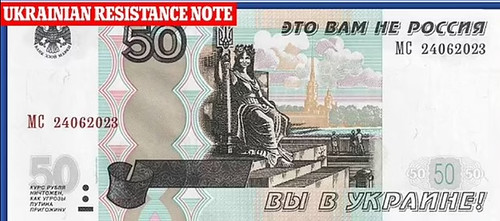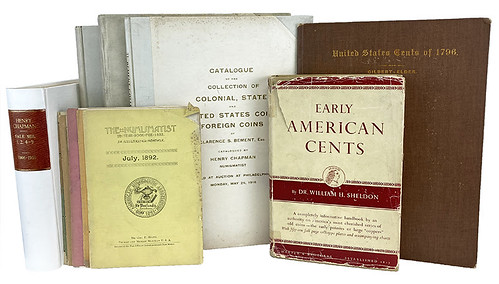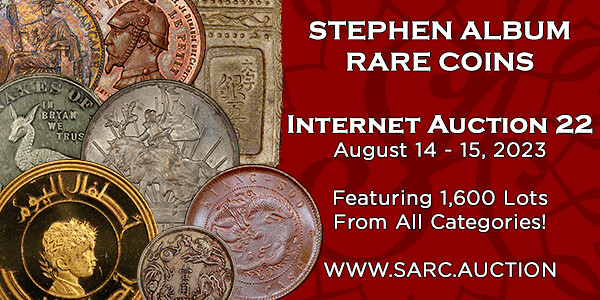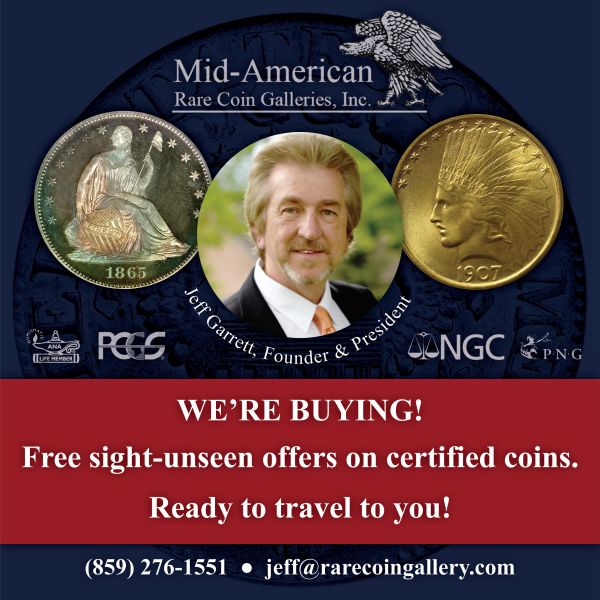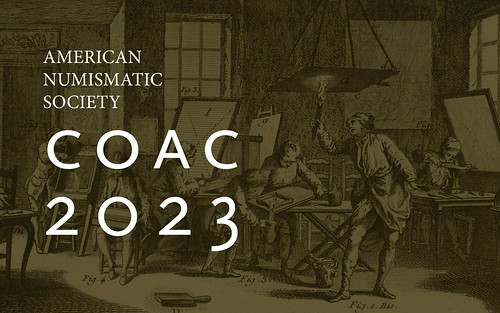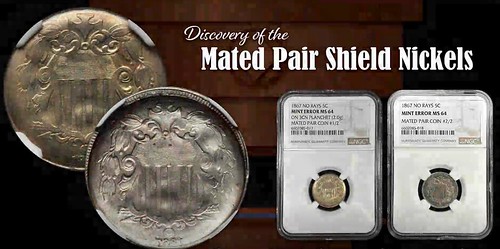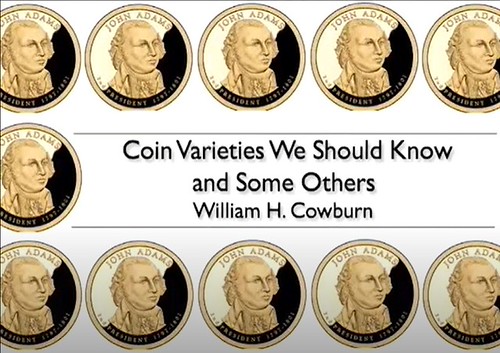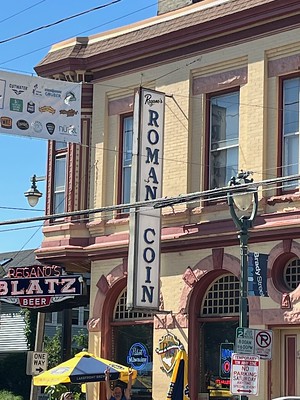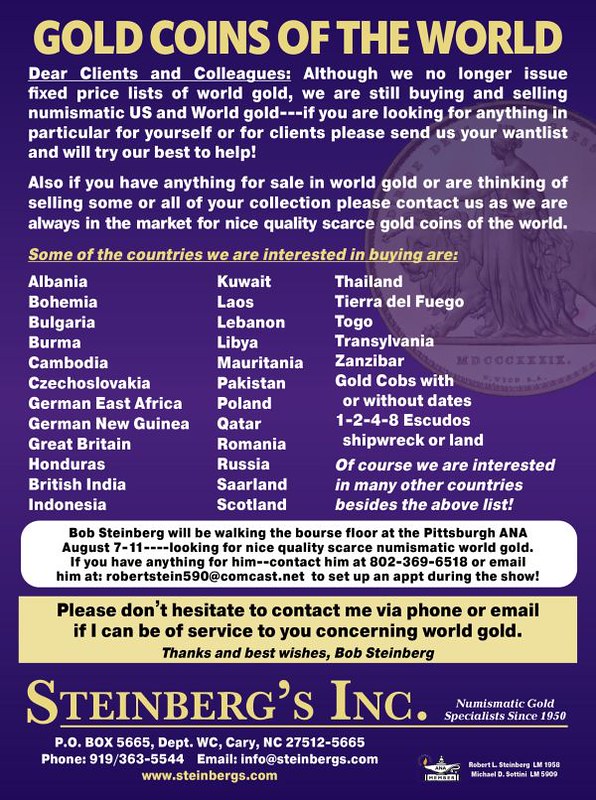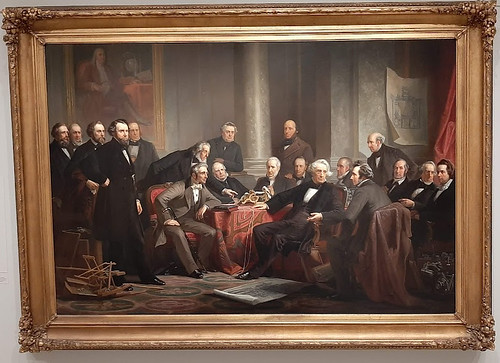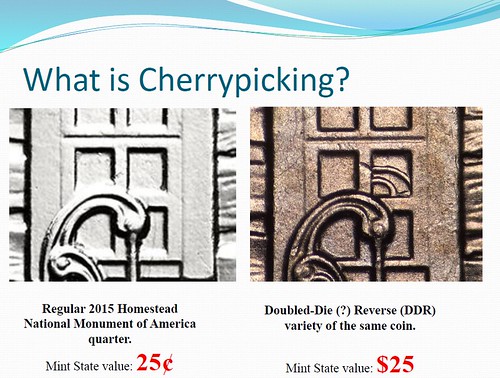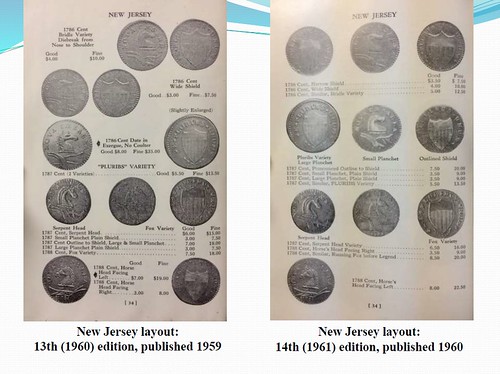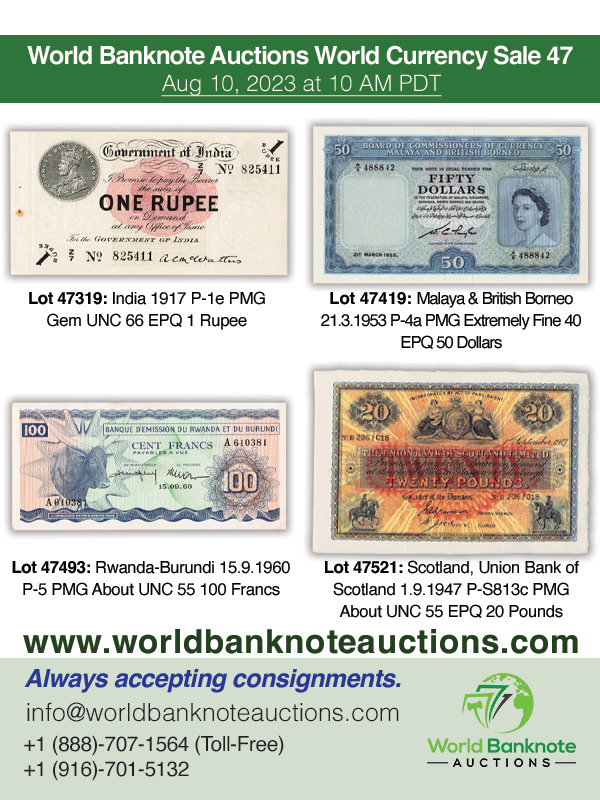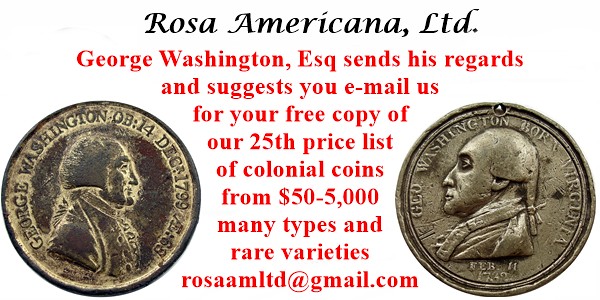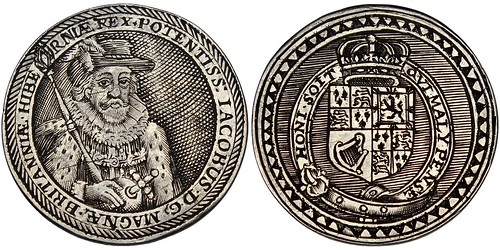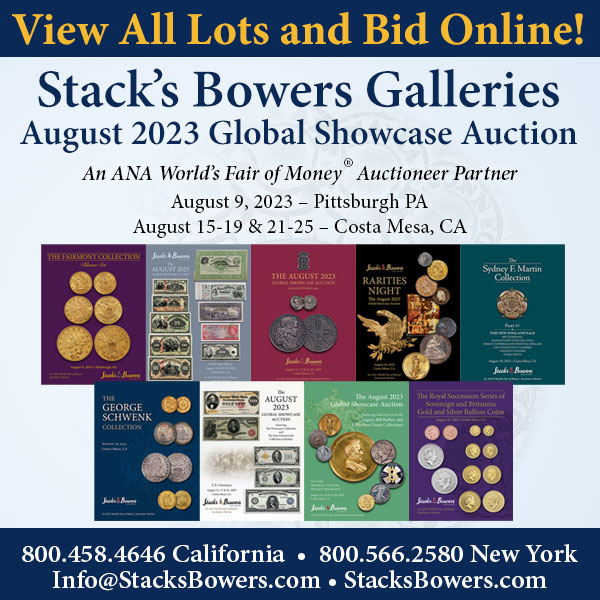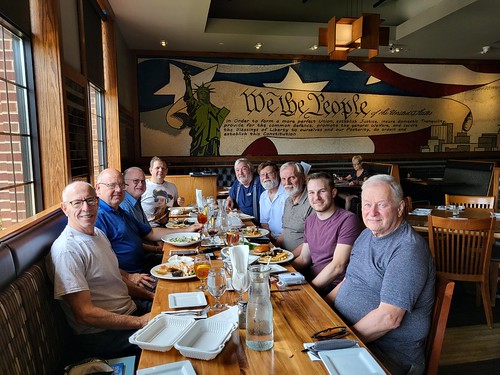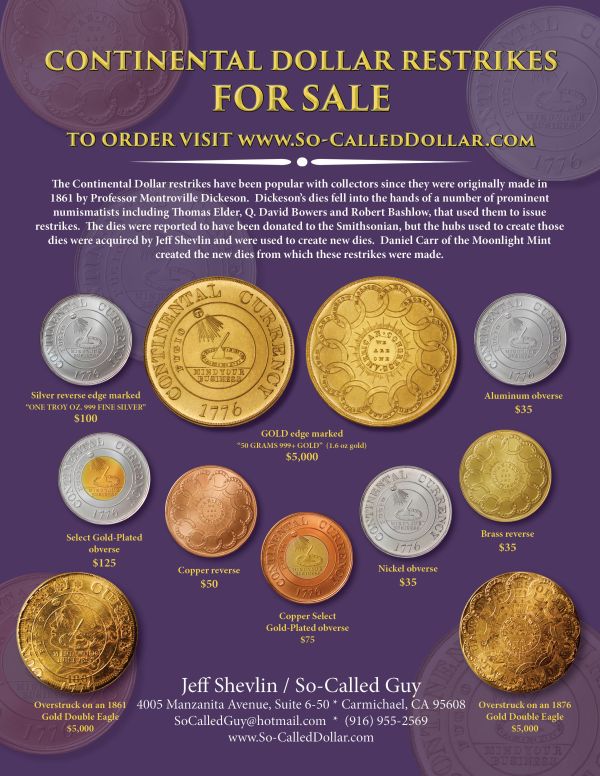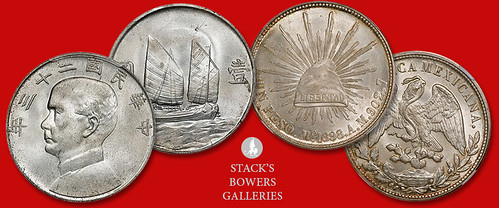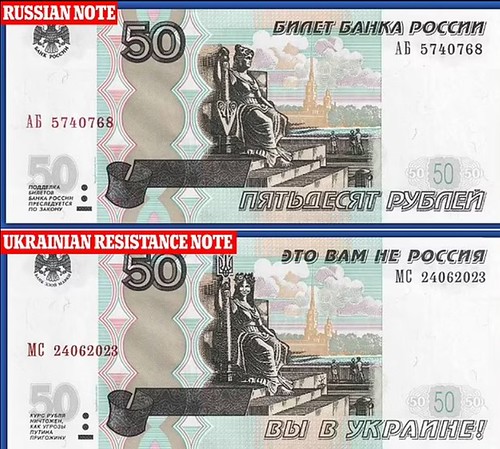
Visit our NBS Sponsors




About UsThe Numismatic Bibliomania Society is a non-profit association devoted to the study and enjoyment of numismatic literature. For more information please see our web site at coinbooks.org SubscriptionsThose wishing to become new E-Sylum subscribers (or wishing to Unsubscribe) can go to the following web page link MembershipThere is a membership application available on the web site Membership Application To join, print the application and return it with your check to the address printed on the application. Print/Digital membership is $40 to addresses in the U.S., and $60 elsewhere. A digital-only membership is available for $25. For those without web access, write to: Charles Heck, Treasurer AsylumFor Asylum mailing address changes and other membership questions, contact Chuck at this email address: treasurer@coinbooks.org SubmissionsTo submit items for publication in The E-Sylum, write to the Editor at this address: whomren@gmail.com BUY THE BOOK BEFORE THE COIN |
- WAYNE'S WORDS: THE E-SYLUM AUGUST 6, 2023
- NBS EVENTS AT THE 2023 PITTSBURGH ANA
- 2023 NBS BENEFIT AUCTION
- NBS BOOKBINDING DEMO
- NEW BOOK: DUTCH COINS 1795-2001
- NEW BOOK: JOHANN-BAPTIST FRENER
- NEW BOOK: THE RUBLE
- NEW BOOK: THE COUNTRY SURGEON
- BOOK REVIEW: 2021 NUMISMATIC HALL OF FAME
- WIZARD COIN SUPPLY CUSTOMER MILESTONE
- 2023 COINAGE OF THE AMERICAS CONFERENCE
- AMERICAN PHILATELIC RESEARCH LIBRARY DIGITIZATION
- NEWMAN PORTAL ADDS MATED PAIR VIDEO
- VIDEO: U.S. COIN VARIETIES
- REGANO'S ROMAN COIN
- MORE ON JOSEPH SAXTON
- EXPRESSING DENOMINATIONS ON US COINS
- NOTES FROM E-SYLUM READERS: AUGUST 6, 2023
- ANA TALK: GERMAN IDENTITY IN MEDALLIC SCULPTURE
- ANA TALK: CHERRYPICKING IN 2023 AND BEYOND
- ANA TALK: THE CHANGING LANDSCAPE OF COLONIAL COINS
- VOCABULARY TERM: NICKEL-SILVER
- ROBERT LEROY HIGGINS
- MIKE DIAMOND INTERVIEW, PART THREE
- NUMISMAGRAM MEDAL SELECTIONS: AUGUST 6, 2023
- VILA RICA MOEDAS AUCTION 17
- MDC OCTOBER 2023 FRENCH COLLECTION
- THURSDAY LUNCH CLUB REPORT JULY, 2023
- U.S. MINT STRUCK PESOS, JUNK DOLLARS
- MORE ON PAULI MURRAY
- THE QUARTER'S ABOUT-FACE
- UKRAINE'S RESISTANCE RUBLES
Click here to read the thin version on the web
Click here to subscribe
Click here to access the complete archive
To comment or submit articles, reply to whomren@gmail.com
Content presented in The E-Sylum is not necessarily researched or independently fact-checked, and views expressed do not necessarily represent those of the Numismatic Bibliomania Society.
WAYNE'S WORDS: THE E-SYLUM AUGUST 6, 2023
 New subscribers this week include:
Mike Brooks,
Dan Knight,
Wayne Shelby and
Matt Virga, all courtesy of Ray Williams;
Bill Edwards, courtesy Terry Freed,
Keith Dieterly, courtesy Jeff Rill of CNG, and
Liza Claar, courtesy Dick Hanscom.
Welcome aboard! We now have 8,048 subscribers.
New subscribers this week include:
Mike Brooks,
Dan Knight,
Wayne Shelby and
Matt Virga, all courtesy of Ray Williams;
Bill Edwards, courtesy Terry Freed,
Keith Dieterly, courtesy Jeff Rill of CNG, and
Liza Claar, courtesy Dick Hanscom.
Welcome aboard! We now have 8,048 subscribers.
Thank you for reading The E-Sylum. If you enjoy it, please send me the email addresses of friends you think may enjoy it as well and I'll send them a subscription. Contact me at whomren@gmail.com anytime regarding your subscription, or questions, comments or suggestions about our content.
This week we open with multiple NBS events at the Pittsburgh ANA, four new books, a book review, the 2023 COAC, updates from the Newman Numismatic Portal, and more.
Other topics this week include Dutch coins, the ruble, digitization, coin errors and varieties, Joseph Saxton, Mike Diamond, Pauli Murray, denominations on U.S. coins, and Ukrainian resistance banknotes.
To learn more about Shanna Schmidt's numismatic library, Johann-Baptist Frener, Arthur Andrews, Wizard Coin Supply, the unique 1867 Shield nickel mated pair error, Regano's Roman Coin, plug nickels, nickel-silver, Bob Higgins, faux-engraved jetons, Junk dollars, buchbindungsblut, and the nakedness of numismatic emperors, read on. Have a great week, everyone!
Wayne Homren
Editor, The E-Sylum
NBS EVENTS AT THE 2023 PITTSBURGH ANA
The numismatic bibliophile events at next month's American Numismatic Association show in Pittsburgh are almost here! As a reminder, here's a repeat of our article from a few weeks back. -Editor
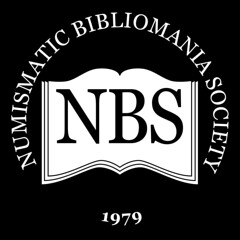 With the 2023 ANA World's Fair of Money in Pittsburgh only weeks away I wanted to
share some highlights of the Numismatic Bibliomania Society's events. From Tuesday through
Friday the NBS will host our club table (#433) located near literature dealers Charles Davis and
Kolbe & Fanning. The table will provide an opportunity to receive a commemorative NBS coffee
mug with a $25 donation and view highlights from Friday's charity auction. Please be sure to
stop by on Wednesday, August 9th for a special book binding demonstration. Members will be
able to make their own updated The Asylum index for vols. 31-40 (2013-2022) that will take
about 45 minutes. Copies of the book will be made available to all NBS members at a future
date. Like all of our gatherings, the table is a great chance to connect with old friends and meet
new literature enthusiasts.
With the 2023 ANA World's Fair of Money in Pittsburgh only weeks away I wanted to
share some highlights of the Numismatic Bibliomania Society's events. From Tuesday through
Friday the NBS will host our club table (#433) located near literature dealers Charles Davis and
Kolbe & Fanning. The table will provide an opportunity to receive a commemorative NBS coffee
mug with a $25 donation and view highlights from Friday's charity auction. Please be sure to
stop by on Wednesday, August 9th for a special book binding demonstration. Members will be
able to make their own updated The Asylum index for vols. 31-40 (2013-2022) that will take
about 45 minutes. Copies of the book will be made available to all NBS members at a future
date. Like all of our gatherings, the table is a great chance to connect with old friends and meet
new literature enthusiasts.
2023 NBS BENEFIT AUCTION
Every year at the ANA convention, our sponsor NBS holds an auction of donated material to raise funds for the club. Bidding is open to all, and you needn't attend in person. Check out the catalog - there is some stupendous material here, thanks to our generous donors. Pitch in as a generous bidder and add to your library! -Editor
Each year at the ANA World's Fair of Money, the Numismatic Bibliomania Society conducts a charity auction to raise funds for the organization. All items sold are donated to the NBS by members and 100% of the proceeds go to the NBS treasury.
Absentee bids should be sent to David Fanning at
df@numislit.com by the end of Thursday, August 10.
NBS BOOKBINDING DEMO
The Numismatic Bibliomania Society table at this summer's American Numismatic Association World's Fair of Money® will feature a special live bookbinding demonstration. Len Augsburger submitted this final pre-show reminder. -Editor
Bookbinding Term of the Week
Our bookbinding term of the week is buchbindungsblut,
a new word in the bookbinder's lexicon, which comes to us courtesy of ChatGPT. This refers to the occasional drop of blood that may result from accidental usage of a bookbinding needle. Never fear, as we will have a supply of BandAids on hand for the NBS bookbinding demo, just in case! See everyone Wednesday at table 433. Pictured here is a sample of the text block that we will be assembling during the demo.
NEW BOOK: DUTCH COINS 1795-2001
Laurens Schulman writes, "We are now in the final phase of digitizing and updating the standard work of the Dutch coins, originally written by my grandfather Jacques Schulman. It is freely accessible for anyone to view." -Editor
The descriptions of many coins bear the so called Schulman-number. Sometimes written out in full, but more often abbreviated to LSch. 150 (Sch.152). What is the origin of this Schulman-number and what does it mean?
Origin
During the German occupation of our country a curfew prohibited people to be outside after 8 o'clock pm. Jacques Schulman spent these long winter evenings gathering numismatic data, often aided by a carbide or oil lamp. Many of these data he took from the card index that had been kept up to date since the late 18hundreds by the Schulman numismatists. In this card index all the coins and medals were each described that had passed through Schulman's hands.
NEW BOOK: JOHANN-BAPTIST FRENER
Matt Ruttley has published a substantial new work on the life and work of engraver Johann-Baptist Frener. Congratulations! -Editor
Johann-Baptist Frener: Life & Works 1821-92
By
Matthew Ruttley
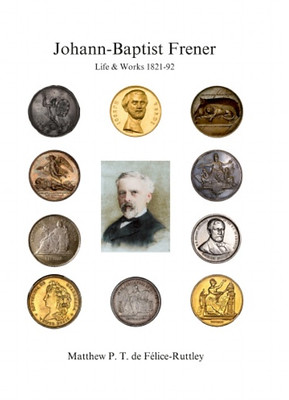 A biography and catalogue of the known works of the artist Johann-Baptist Frener (b. Luzern 1821, d. Guatemala City 1892). Frener was late 19th century Central America's finest engraver, producing a plethora of coins, medals, engravings and sculptures. An orphan child prodigy, Frener's talents earned him a place in Paris at the École des Beaux-Arts, under the tutelage of Bovy, Pradier and Ingres. Following his studies, he moved to Florence, Munich and then back to Luzern where he produced the spectacular 1853 Shooting Thaler.
A biography and catalogue of the known works of the artist Johann-Baptist Frener (b. Luzern 1821, d. Guatemala City 1892). Frener was late 19th century Central America's finest engraver, producing a plethora of coins, medals, engravings and sculptures. An orphan child prodigy, Frener's talents earned him a place in Paris at the École des Beaux-Arts, under the tutelage of Bovy, Pradier and Ingres. Following his studies, he moved to Florence, Munich and then back to Luzern where he produced the spectacular 1853 Shooting Thaler.
Disappointingly, he was not able to secure the contract to engrave the unified Swiss coinage of 1850, but by chance a Guatemalan commission sent to Europe by President Rafael Carrera noticed his work. He moved to Guatemala City and rejuvenated the country's coinage with the assistance of organisations such as the Sociedad Económica, a quasi-governmental body established during the enlightenment. Word spread, resulting in further commissions from the mints of Honduras and El Salvador. Aside from his regular work, many beautiful and rare medals were commissioned as diplomatic gifts for Ulysses S. Grant, Guzmán Blanco of Venezuela, the 1889 Exposition Universelle in Paris, the composer Verdi and Queen Isabella II of Spain.
NEW BOOK: THE RUBLE
Last week we discussed the 1992 Russian privatization vouchers, and there is some follow-on discussion elsewhere in this issue. A new new book on the paper ruble examines the complete history of the country's currency. Here's an excerpt of a review from the Wall Street Journal. -Editor
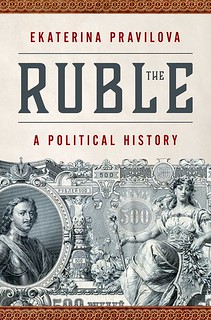 When reading Ekaterina Pravilova's original, fascinating and meticulously researched
When reading Ekaterina Pravilova's original, fascinating and meticulously researched The Ruble
it is a good idea to keep in mind its subtitle: A Political History.
For Ms. Pravilova's multi-layered account of the evolution of the paper ruble from its inception in the mid-18th century until the post-revolutionary reforms in the early 1920s goes beyond the merely monetary. The biography of the ruble,
explains Ms. Pravilova, is a history of the Russian state, written in the language of money.
Regardless of the type of political system in place, she writes, money does not simply reflect an existing (or imagined) social and political order but creates it; it is not a consequence or an attribute but an integral and constitutive part of any regime.
Ms. Pravilova, a professor of history at Princeton, shows that the ruble has been, above all, a symbol and an instrument of centralized, autocratic and imperial power.
The story begins in 1769 with the launch, under Catherine the Great, of assignats, Russia's first paper currency. This was, Ms. Pravilova maintains, a risky move. Historically, money had been a token of legitimacy,
an indication of the pureness and integrity of monarchical power.
But even in Catherine's time, the figurative, if not the literal, flimsiness of paper money posed both economic and political dangers to the absolutist state.
NEW BOOK: THE COUNTRY SURGEON
There's a new book about Dr Arthur Andrews, author of the classic book, Australasian Tokens and Coins. Co-author Charles Stitz discussed Andrews in an earlier presentation to the Albury & District Historical Society. -Editor
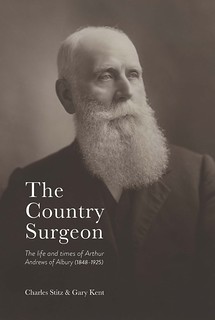 I can't recall what sparked my recent interest in Dr Andrews, but I first heard of him some 60 years ago,
during my coin collecting days in Sydney, when I was much impressed by his 1921 landmark work on Australasian
Tokens and Coins. He had also been President of the Numismatic Society of Victoria in 1914, and I had filled the
same role in the Sydney-based Australian Numismatic Society in the 1960s.
I can't recall what sparked my recent interest in Dr Andrews, but I first heard of him some 60 years ago,
during my coin collecting days in Sydney, when I was much impressed by his 1921 landmark work on Australasian
Tokens and Coins. He had also been President of the Numismatic Society of Victoria in 1914, and I had filled the
same role in the Sydney-based Australian Numismatic Society in the 1960s.
When we began to look for information on the doctor, we discovered a complex and fascinating character, and wondered (as I still do) why no-one has previously sought to record in detail the life of such an interesting, many-facetted and public-spirited man who, though he largely sought to avoid the limelight, played a very significant part in the development of the town for over forty five years.
Arthur Andrews was born into an old-established family of builders and timber merchants in the village of Brickendon in East Hertfordshire in 1848. His mother, a remarkable woman, who though academically untrained, would now be described as a polymath, in addition to raising eleven children, was an accomplished musician who could also draw and paint. She was also an archaeologist, a geologist and a numismatist, and it's tempting to conclude, without any supporting evidence, that she was the source of Arthur's enquiring mind, and his wide-ranging intelligence and energy. Certainly, the connection between the two of them and the science of numismatics is clear. Sadly, she died at the age of 38, when Arthur was only five.
BOOK REVIEW: 2021 NUMISMATIC HALL OF FAME
Adrián González-Salinas of Monterrey, Nuevo León, Mexico submitted this capsule review of the Tomaska-McNamara book, 2021 Numismatic Hall of Fame. -Editor
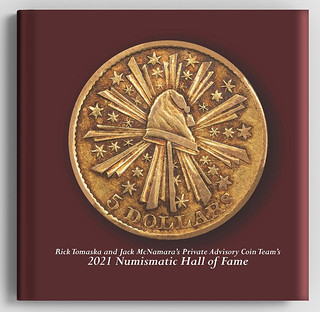 Two weeks ago I bought the book "2021 Numismatic Hall of Fame" by Rick Tomaska & Jack McNamara.
The book contains a lot of superb full color pictures of some USA iconic coins (no medals, notes, tokens).
Two weeks ago I bought the book "2021 Numismatic Hall of Fame" by Rick Tomaska & Jack McNamara.
The book contains a lot of superb full color pictures of some USA iconic coins (no medals, notes, tokens).
Book Dimensions:
Width: 26.2 cms
Length: 26.0 cms
Thickness: 1.5 cms
Pages: (1),113,(4)
Hardcover
I don't believe we've discussed this book before. It's available from Rare Collectibles TV. Their website describes it as "A must have for numismatists, connoisseurs of fine coins and history buffs, Rick Tomaska and Jack McNamara's 2021 Numismatic Hall of Fame book showcases the remarkable and rare coins placed with clients of their Private Advisory Coin Team during 2021. From shipwreck coins rescued from the depths of the ocean to rare territorial issues, this collection runs the gamut of United States coinage. Featuring 115 pages of RCTV's industry leading and spectacular coin photography, this is a collection you will want to display and refer to again and again. Forward by numismatists and authors, Rick Tomaska and Jack McNamara."
The cover image is the 1849 Pacific Company Gold Half Eagle. Adrián's summary continues below. -Editor
WIZARD COIN SUPPLY CUSTOMER MILESTONE
Congratulations to our good friend Wayne Herndon for reaching a new milestone - his Wizard Coin Supply has served its millionth customer. -Editor
Wizard Coin Supply Celebrates One Millionth Customer Milestone
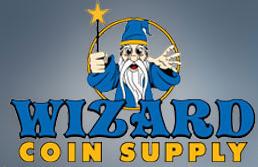 Wizard Coin Supply, an online retail store focusing on coin, stamp, comic book, and card collecting supplies, has welcomed its one millionth customer on July 23, 2023. These one million customers have purchased products from Wizard on the
WizardCoinSupply.com website, through marketplaces such as eBay and Amazon and at trade shows including the FUN (Florida United Numismatists) and ANA (American Numismatic Association) shows.
Wizard Coin Supply, an online retail store focusing on coin, stamp, comic book, and card collecting supplies, has welcomed its one millionth customer on July 23, 2023. These one million customers have purchased products from Wizard on the
WizardCoinSupply.com website, through marketplaces such as eBay and Amazon and at trade shows including the FUN (Florida United Numismatists) and ANA (American Numismatic Association) shows.
Wizard Coin Supply opened its doors in 2008 and quickly became the go-to supplier in the world of coin, paper money, stamp, comic book, and card collecting supplies. Owned by Wayne Herndon, Wizard Coin Supply grew into the collectors' market with high quality, yet affordable collectors supply items. With an inventory of over 20,000 different products, collectors know Wizard is the place to obtain those hard to find, esoteric items while also getting the best pricing available on the widely available items.
2023 COINAGE OF THE AMERICAS CONFERENCE
Speakers have been announced for the 2023 American Numismatic Society Coinage of the Americas. What a great lineup! -Editor
2023 Coinage of the Americas Conference:
18th & 19th Century Design and Production
SPONSORED BY THE RESOLUTE AMERICANA COLLECTION & THE STACK FAMILY.
September 22–23, 2023
9:00 AM–4:00 PM
American Numismatic Society
75 Varick Street, Floor 11
New York, NY
THE BOOK BAZARRE
AMERICAN PHILATELIC RESEARCH LIBRARY DIGITIZATION
As numismatic bibliophiles are aware, many early hobbyists in the U.S. collected widely, accumulating holdings of antiquities, antiques, and artifacts as well as both coins and stamps. Early articles discussing coins can be found well beyond the specialized numismatic publications we're all familiar with today, and a number of such publications can be found in the holdings of the library of the American Philatelic Society.
Several years ago, the American Philatelic Research Library launched a digitization effort similar to the Newman Numismatic Portal, but behind a paywall. This resource became open access in 2022, and a recent donation will enable further digitization. -Editor
Robert A. Mason Collection Sale Raises $229,000 for Library Digitization
"When Bob retired, he started visiting for days at a time, and developed deep relationships with the staff here, recalled Scott English, the APS executive director, in a recent phone conversation about Robert A. Mason's unexpected — and hefty — 2017 bequest to the American Philatelic Research Library.
With no family of his own, Mr. Mason in his later years had found companionship and support at the library, often inviting staff to lunch.
What's unique about Bob is that he never popped up on anybody's fund-raising radar,
English continued. It's really a testament to how amazing our staff is that he decided to leave everything he had
to the organization when he died.
NEWMAN PORTAL ADDS MATED PAIR VIDEO
The latest addition to the Newman Numismatic Portal is a video on the recent discovery of a remarkable 1867 Shield nickel mated pair error. Project Coordinator Len Augsburger provided the following report. -Editor
Mated Pair Discovery Inspires Video
First reported by the Numismatic News on May 2, the discovery of an 1867 Shield nickel mated pair error represents one of the more remarkable finds in the U.S. series in recent memory. The pair originated as two planchets, intended for a nickel 3-cent piece and for a Shield nickel. The 3-cent planchet was first struck with the Shield nickel dies, and then restruck after landing on top of a Shield nickel planchet. Collector Greg Bennick, who pieced together the whole story after purchasing the pair from Heritage Auctions in December 2022, tells the tale in this video produced by Lianna Spurrier.
VIDEO: U.S. COIN VARIETIES
The David Lisot Video Library on the Newman Numismatic Portal can be found at:
https://nnp.wustl.edu/library/multimediadetail/522852
We highlight one of his videos each week in The E-Sylum. Here's one from 2007 with Bill Cowburn talking about U.S. coin varieties. -Editor
REGANO'S ROMAN COIN
Last week a reader challenged us to name the location of this coin-themed establishment. -Editor
"A quick internet search suggests Regano's Roman Coin Bar in Milwaukee, WI is the photo supplied. It specializes in local craft beers and suggests that clients bring in food from local eateries close by."
Yeah, that turned out to be an easy one. -Editor
Ken Barr writes:
"Too easy, didn't even have to Google it ... Milwaukee WI, but I thought it was a bar rather than a restaurant.
If I remember correctly, a bunch of us (possibly an NBS mini-gathering) were going to go here for a drink during the 1986 ANA convention, but plans fell apart (perhaps in favor of the NLG Bash instead). Cal Wilson and John Bergmann were undoubtedly heavily involved in planning the escapade as they were sharing a booth at that convention ..."
MORE ON JOSEPH SAXTON
Last week I asked about Joseph Saxton's contributions to the history of minting and photography; he was pictured among 19 prominent "Men of Progress" in this 1862 painting at the National Portrait Gallery. -Editor
EXPRESSING DENOMINATIONS ON US COINS
Last week I remarked about the cent sign now appearing on some U.S. coins. -Editor
Gary Dunaier writes:
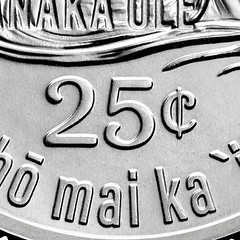 "Regarding the Edith Kanaka?ole quarter's face value being expressed as "25¢:"
"Regarding the Edith Kanaka?ole quarter's face value being expressed as "25¢:"
"Yes, it's the first time we're seeing it shown that way. But it's not the first time numerals were used to indicate the value. The Draped Bust and Capped Bust quarters from 1804 to 1838 were denominated "25 C."
"Two of the 2024 American Woman quarters will also have the value expressed as "25¢" - Celia Cruz, as already mentioned, and Rev. Dr. Pauli Murray. But the other three (Patsy Takemoto Mink, Dr. Mary Edwards Walker, Zitkala-Ša) will have another U.S. coinage first - they'll be denominated "25 CENTS."
"Technically, 2024 will be the first year since 1892 that the U.S. will not be issuing any "quarter dollars.""
NOTES FROM E-SYLUM READERS: AUGUST 6, 2023
More on Tassie Coin Impressions
Don Goddeau writes:
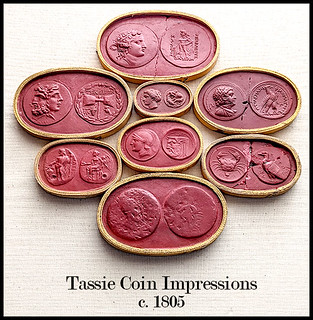 "Great to see some interest in Tassie. Thanks to all. In addition to Ed Moore's E-Sylum article, he sent photos of what may be Tassie's enamel copies of ancient Greek gems. Still investigating. Forwarded copies to great folks at the Hunterian.
"Great to see some interest in Tassie. Thanks to all. In addition to Ed Moore's E-Sylum article, he sent photos of what may be Tassie's enamel copies of ancient Greek gems. Still investigating. Forwarded copies to great folks at the Hunterian.
"From Scottish National Galleries: Tassie collection in deep storage
. Trying to figure out how to thaw them out. This is currently the best possibility to find coin impressions by Tassie.
"John Sallay sent a copy of his article University of Glasgow medals by James Tassie
that he mentioned, which was published in The MCA Advisory, September 2019 (Volume 22, No. 3). Great background on Tassie and early Tassie medals.
"To date no one is familiar with the double-faced copies of coins.
"Folks at Hunterian in Glasgow and National Galleries of Scotland in Edinburgh have been very interested and cooperative. Will meet with them in September. Looking forward to it.
"Until then I'll keep looking for leads. Thanks for your interest and help. I'll let you know how it turns out."
Thanks, and good luck with the research! -Editor
Daniel Fearon writes:
"Good to see Hadrien is also paying attention!"
To read the earlier E-Sylum article, see:
NOTES FROM E-SYLUM READERS: JULY 30, 2023 : More on Tassie Coin Impressions
(https://www.coinbooks.org/v26/esylum_v26n31a13.html)
Other topics this week include Silk Purse Coins and the Attribution Opinion Business, and Russian Privatization Vouchers. -Editor
ANA TALK: GERMAN IDENTITY IN MEDALLIC SCULPTURE
Dennis Tucker of Whitman Publishing will be a busy speaker at this week's ANA event. Here's the first of three press releases with details. My show schedule is getting full, but I hope to attend some of these. -Editor
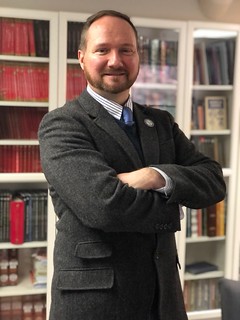 As part of the 2023 Sundman Lecture Series symposium at the American Numismatic Association World's Fair of Money, Dennis Tucker will present
As part of the 2023 Sundman Lecture Series symposium at the American Numismatic Association World's Fair of Money, Dennis Tucker will present Changing German National Identity in Royal and Imperial Medallic Sculpture.
The presentation is scheduled for Wednesday, August 9, at 10:00 a.m. in room 330 of the David L. Lawrence Convention Center in Pittsburgh.
The theme of the 2023 Sundman Lecture Series is The Numismatics of Nation Building; Money, Medals, Tokens and National Identity.
The program's four lectures focus on how coinage, paper currency, medals, and tokens have been used to create, record, and/or modify national identity since the ancient Greeks used their money to announce the creation of new states, a phenomenon which continues to this day wherever new nations appear.
Tucker's lecture hinges on the assertion, in Otto von Bismarck's memoirs, that German patriotism, to be active and effective, needs as a rule to be dependent upon a dynasty. . . . The German's love of the fatherland needs a prince on whom he can concentrate his attachment.
Bismarck wrote this after successfully transforming the most powerful German monarch into a new German emperor, a nineteenth-century Charlemagne.
ANA TALK: CHERRYPICKING IN 2023 AND BEYOND
The second of Dennis Tucker's talks is on "cherrypicking" rare die varieties. -Editor
Whitman publisher Dennis Tucker will give a Money Talks presentation at the 2023 American Numismatic Association World's Fair of Money in Pittsburgh. Cherrypicking Rare Coins in 2023 and Beyond
is scheduled for Thursday, August 10, at 2:00 p.m. in room 330 of the David L. Lawrence Convention Center.
Many rare and valuable die varieties have been discovered in recent years. They're waiting to be cherrypicked
—found in dealers' inventories by sharp-eyed collectors and bought for regular-coin prices. This presentation explores today's cherrypicking scene with special emphasis on half dimes, dimes, twenty-cent pieces, and quarter dollars from the early 1800s to modern pocket change. These denominations include many of America's most popular coin series: Mercury and Roosevelt dimes, Washington quarters, Liberty Seated and Barber coinage, and more. Tucker also gives an overview of the history of cherrypicking, sharing anecdotes from collectors and researchers including Bill Fivaz (coauthor of the standard reference, the Cherrypickers' Guide to Rare Die Varieties of U.S. Coins).
ANA TALK: THE CHANGING LANDSCAPE OF COLONIAL COINS
The third of Dennis Tucker's talks is a discussion of changes in the way colonial coins and tokens have been covered in the Red Book over the past 75-plus years. -Editor
Dennis Tucker, publisher at Whitman Publishing, will present The Changing Landscape of Colonial Coins
at the 2023 American Numismatic Association World's Fair of Money in Pittsburgh. The presentation is scheduled for Friday, August 11, at 4:00 p.m. in room 330 of the David L. Lawrence Convention Center.
Colonial coins and tokens have long been a serious—and fun—specialty in American numismatics. This presentation explores how coin collectors have looked at colonials over the years, as illustrated by how their coverage has evolved since 1946 in the Guide Book of United States Coins (the Red Book
). It's also the behind-the-scenes story of hobby legends like R.S. Yeoman, Kenneth Bressett, Q. David Bowers, and Jeff Garrett, all of whom have taken an active interest in colonial coins and coppers in the Red Book.
Tucker gives a look at today's changing hobby world, including controversies and groundbreaking new research.
VOCABULARY TERM: NICKEL-SILVER
Here's another entry from Dick Johnson's Encyclopedia of Coin and Medal Terminology. -Editor
Nickel-silver. An alloy of nickel, copper and zinc. Its gray-white color is in imitation of silver; but there is no silver in nickel-silver. Formerly this alloy was widely known as german-silver, but this term fell into disuse in World War I due to anti-German sentiment in England and America. While German-silver was known as early as the 1830s (from natural alloys found in Germany) it was not until the 1840s when experiments in England were conducted with brass. Nickel was added to brass until the gold-colored alloy turned silver-gray. By 1848 a successful nickel-brass alloy was in use, it was called albata.
There are many nickel-silver formulas: 55-65 copper, 5-25 nickel, 10-30 zinc.
ROBERT LEROY HIGGINS
E-Sylum Feature Writer and American Numismatic Biographies author Pete Smith submitted this article on dealer Bob Higgins. Thanks! -Editor
I attended the 2011 Central States show as a table assistant working for a local coin dealer. My boss was aware that I was at the time looking for 1792 half dismes. On April 29, He came back to the table after visiting Certified Asset Management and told me they had a mint state example in their inventory.
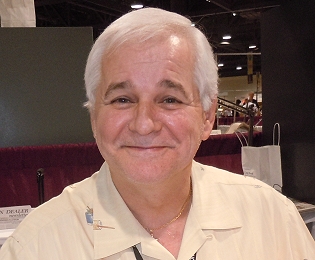 I looked at the coin, made some notes and talked with the owner. Bob Higgins was very open and
generous with information about the coin and two others he had handled.
I looked at the coin, made some notes and talked with the owner. Bob Higgins was very open and
generous with information about the coin and two others he had handled.
I was aware that Higgins had been associated with Tom Noe and learned about a very
complicated pedigree involving Rare Coin Alliance and the Cardinal
coin. At his level, coins
were commodities to be traded to make a profit and a clean pedigree was irrelevant.
THE BOOK BAZARRE
MIKE DIAMOND INTERVIEW, PART THREE
Here's the third part of Greg Bennick's CONECA interview with collector and writer Mike Diamond, covering stutter strikes and other discoveries. Thanks again to Greg, ErrorScope Editor Allan Anderson, and CONECA for making this available here. -Editor
Greg Bennick: Can you tell us what stutter strikes are, just for the uninformed among us.
Mike Diamond: Sure. There are three types which I imagine I can call Type 1, Type 2, and Type 3. Type 1 involves a slightly off-center coin with one pole sitting on top of the collar. The hammer die comes down. The collar has to be a stiff collar. The hammer die comes down and makes an initial impression, then skips to one side and continues its downstroke to complete the strike, leaving a thin crescent of die-struck design lying outside the complete design.
NUMISMAGRAM MEDAL SELECTIONS: AUGUST 6, 2023
Jeremy Bostwick at Numismagram sent along these four tokens and medals from his most recent addition of new material. For all of the newest additions, please visit https://www.numismagram.com/inventory
The faux-engraved jetons are very interesting. I haven't seen any of these in person yet, but I'll be on the lookout for them. Can anyone add information on the manufacturing process? -Editor
102475 | GREAT BRITAIN. England. James I silver faux-engraved Jeton or Gaming Counter. Issued circa 1720, or slightly later. Series 5: Sovereigns of England: Half length (25mm, 2.78 g, 12h). By the school of Simon van der Passe. IACOBUS D G MAGNÆ BRITANNIÆ HIBERNIÆ REX POTENTISS, capped and ermine-mantled bust facing slightly right, holding scepter and orb, and wearing ruffled collar // Crowned coat-of-arms within Collar of the Garter; all within elaborate border. Cf. Mitchener p. 1675, 26. Choice Extremely Fine. Very lightly toned, with excellent and highly intricate artistry. A fairly rare later type from a popular series. $365.
Gambling and games of chance have served as a form of entertainment and excitement during much of recorded history in one way or another, and many of these games necessitate some form of accounting during play. In early modern Europe, jetons were commonly employed for these purposes and allowed for skilled engravers to promote their artistry. One such engraver was Simon van der Passe, born in Utrecht circa 1585.
Van der Passe worked in England from 1616–1621/2, having founded a school after being exempted from the royal monopoly given previously to Nicholas Hilliard. This exemption allowed for the "graving and imprinting medailles" and small portraits of the king, and van der Passe utilized his technique for the production of numerous series of jetons or gaming counters, initially employing portraits of the Stuarts, James I and later Charles I with his wife, Henrietta Maria. Though Simon would return to Holland in 1621/2, his London-based school continued under the management of his brother, William. Subsequent issues of these jetons would feature Gustav Adolph and his wife, Maria Eleonora, the sovereigns of England, 'classical portraits' of historical and biblical figures, 'street cries,' and the Commonwealth.
Of even greater interest and debate among numismatists over the past century has been the method of manufacture of these jetons. Their appearance at first glance would lead one to believe that they have been individually engraved owing to their incuse design. It is thought that, in fact, these ornate counters were skillfully cast (or struck) and polished through the niello process in order to generate this 'faux-engraved' effect.
To read the complete item description, see:
102475 | GREAT BRITAIN. England. James I silver faux-engraved Jeton.
(https://www.numismagram.com/product-page/102475)
VILA RICA MOEDAS AUCTION 17
Vila Rica Moedas of Brazil will hold an auction August 15-16, 2023. Here's the announcement and highlights. -Editor
 Vila Rica Moedas (www.vilaricamoedas.com) is a Numismatic company based in São Paulo,
Brazil, and it is run by its two partners David André Levy and Hilton Lúcio, both authors of
reference catalogs and accomplished numismatists.
Vila Rica Moedas (www.vilaricamoedas.com) is a Numismatic company based in São Paulo,
Brazil, and it is run by its two partners David André Levy and Hilton Lúcio, both authors of
reference catalogs and accomplished numismatists.
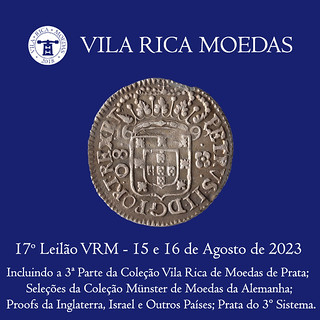 Vila Rica will hold its Auction 17 on August 15th and 16th. The
auction is internet-only and split over two sessions. It will offer
a vast range of Brazilian coins from Colonial to Republican
issues, featuring the 3rd part of the Vila Rica Collection of Silver
Coins (despite the name, the collection is not related to the
auction house). Also featured in this auction will be selections
of the Münster Collection of Silver Coins, modern proofs from
England, Israel and other countries, and a collection of Imperial
and Republican silver coins (3rd System).
Vila Rica will hold its Auction 17 on August 15th and 16th. The
auction is internet-only and split over two sessions. It will offer
a vast range of Brazilian coins from Colonial to Republican
issues, featuring the 3rd part of the Vila Rica Collection of Silver
Coins (despite the name, the collection is not related to the
auction house). Also featured in this auction will be selections
of the Münster Collection of Silver Coins, modern proofs from
England, Israel and other countries, and a collection of Imperial
and Republican silver coins (3rd System).
The Vila Rica Collection is one of the most accomplished collections of silver coins ever put together, and the most important one to be auctioned on recent years. The first part was sold by Heritage Auctions in May 2021 and the second part was sold by Vila Rica Moedas in December 2022. The collection is famous for the high standards of the collector, resulting on a high quality of its coins as a set. The third part is focused on fractions, of note the early colonial ones which are very rare to find in decent condition.
Some highlights of the sale follow:
MDC OCTOBER 2023 FRENCH COLLECTION
MDC Monaco's Auction No. 12 in October 2023 will feature a notable collection of French coins from the French Revolution to the Fifth Republic. Here's the press release. Beautiful coins! -Editor
At MDC Monnaies de collection, we are excited to present our upcoming auction, The French
Collection
, taking place in October 2023.
This collection of 540 lots, built for over 40 years, gathers the most beautiful coins from the French Revolution to the Fifth Republic, with a vast majority of Top Pop.
The auction will take place in Monaco at the Hôtel Métropole on the 11th of October 2023, from 1:30 pm to 4 pm (lots 1 to 296) and then from 4:15 pm to 7 pm (lots 297 to 540).
Today, it is not possible to recreate such a collection, and we know that many collectors will find in our auction the special coins they have been looking for to complete their collection.
We have printed, on this occasion, a bespoke catalogue. It has been edited to embody the Proustian madeleine that are French coins, a sort of must-have textbook for each numismatist.
THURSDAY LUNCH CLUB REPORT JULY, 2023
On Monday Ray Williams of New Jersey posted the picture and text below to the colonialcoins chat group. I reached out about republishing it here, and the group readily provided additional commentary and images of the numismatic items they'd brought to share with the group. Thanks! Now we can share with E-Sylum readers as well! -Editor
Ray Williams writes:
"For those who subscribe to the E-Sylum, we often get an account of Nummis Nova - a group of prominent numismatists (generally from Northern Virginia) who gather at a nice restaurant to share their hobby interests over some nice food. Food and numismatic friends - can it get any better?
Well, Northern Virginia is not alone in holding a numismatic dinner! Last Thursday the Thursday Lunch Club met at Jimmy's in Bordentown. Nine of us were present and all brought something to share. Coins, error colonials, paper money, colonial documents and yet to be published research documents... A fun couple hours. Check out the wallpaper in the background of the picture!"
U.S. MINT STRUCK PESOS, JUNK DOLLARS
The U.S. Mint struck coins for multiple foreign governments over the years. Chris Bulfinch published a Stack's Bowers blog article about the 1949 strikings of backdated silver Junk dollars
and Mexican pesos.
-Editor
As the Chinese Civil War raged in the late 1940s, the United States made efforts to support the Nationalist Guomindang which, after Japan's defeat at the end of World War II, had lost the initiative to the Communists in the country's decades-long Civil War. In early 1949, the U.S. Mint began striking 1934-dated Junk dollars
to support the Guomindang's flagging currency regime; later in the year, 1898-dated Mexican one-peso coins were struck.
Inflation had been a persistent issue for China through most of the later stages of the Pacific War and remained an issue for both sides in the Civil War as hostilities resumed in 1945. The anticommunist Guomindang launched Silver Yuan Certificates in 1949 to provide a trusted currency as the Gold Yuan fell to inflation; to provide specie reserve for the new notes, back-dated Junk dollars and Mexican pesos were struck at the Mexico City and San Francisco mints. The new silver certificates bore representations of the Junk dollars for which they were redeemable.
MORE ON PAULI MURRAY
This August 6, 2023 article has more background on Pauli Murray, one of the subjects of the Mint's 2024 quarters. -Editor
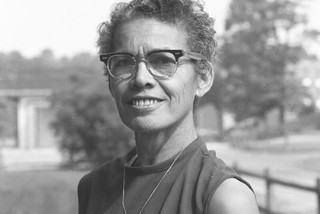 It's official. The U.S. Mint's American Women Quarters Program has announced that a nonbinary Black activist, lawyer, priest and poet will be featured on a quarter in the next round, making her the first Black queer person to appear on U.S. currency.
It's official. The U.S. Mint's American Women Quarters Program has announced that a nonbinary Black activist, lawyer, priest and poet will be featured on a quarter in the next round, making her the first Black queer person to appear on U.S. currency.
Pauli Murray's quarter will be issued in 2024. Others in the 2024 class are Patsy Takemoto Mink, the first woman of color to serve in Congress; Dr. Mary Edwards Walker, a Civil War–era surgeon, women's rights advocate, and abolitionist; Zitkala-Ša, a writer, composer, educator, and activist for Native Americans' rights; and Celia Cruz, the Cuban-American singer known as the Queen of Salsa.
THE QUARTER'S ABOUT-FACE
It's nice to see people outside the hobby taking notice of coin designs. Here's a Crystal River, FL article I came across recently about the updated visage of George Washington on the quarter. I'm seeing these pieces in my change now myself. -Editor
The quarter's about-face, by George
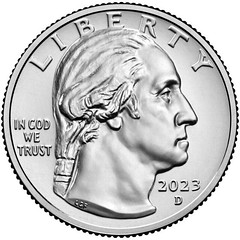 Have you looked at the change in your pocket recently? You may have spotted something new on a familiar coin. Some say it rights an old wrong. Others say there never was a wrong in the first place. Read the evidence and decide for yourself.
Have you looked at the change in your pocket recently? You may have spotted something new on a familiar coin. Some say it rights an old wrong. Others say there never was a wrong in the first place. Read the evidence and decide for yourself.
Americans pride themselves on being master practitioners of innovation and change. Yet when it comes to our coinage, we're downright stodgy. The Lincoln penny is a beloved childhood memory for many, but at 114 years, the obverse (the front) also holds the world record for the longest-running coin without a change. Likewise, the dime is 77 years old, and the half-dollar is practically a kid at 59. (They've tinkered so much with the nickel in recent years, we'll sidestep that one.)
UKRAINE'S RESISTANCE RUBLES
A Ukrainian resistance group makes counterfeit rubles notes to protest occupation. Found via News & Notes from the Society of Paper Money Collectors (Volume IX, Number 7, August 1, 2023) -Editor
Hundreds of 50 Ruble notes are appearing across the Russian-occupied territories of Ukraine - from Melitopol, Berdyansk and Tomak in southern Ukraine all the way to Sevastopol and Yalta in Crimea.
But these are no ordinary Russian banknotes.
In fact, they are part of a campaign designed to undermine the Russian occupation by a Ukrainian, all-female and non-violent resistance group that emerged in the Russian-controlled city of Melitopol late last year.


